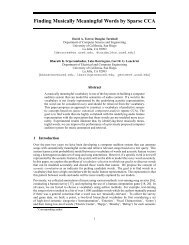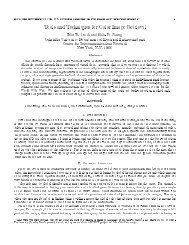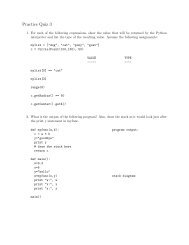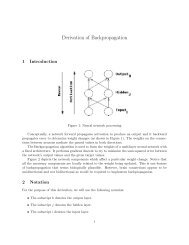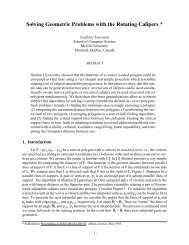Left-leaning Red-Black Trees - Princeton University
Left-leaning Red-Black Trees - Princeton University
Left-leaning Red-Black Trees - Princeton University
You also want an ePaper? Increase the reach of your titles
YUMPU automatically turns print PDFs into web optimized ePapers that Google loves.
Properties of LLRB trees built from random keysBy design, the worst-case cost of a search in an LLRB tree with N nodes is 2 lg N. In practical applications,however, the cost of a typical search is half that value, not perceptibly different fromthe cost of a search in a perfectly balanced tree. Since searches are far more common than insertsin typical symbol-table applications, the usual first step in studying a symbol-table algorithm is toassume that a table is built from random keys (precisely, a random permutation of distinct keys)and then study the cost of searchers. For standard BSTs and other methods, mathematical modelsbased on this assumption have been developed and validated with experimental results and practicalexperience. The development of a corresponding mathematical model for balanced trees is oneof the outstanding problems in the analysis of algorithms.In this paper, we present experimental results that may help guide the development of such amodel, using a modified form of a plot format suggested by Tufte [12]. Specifically, we use• a gray dot to depict the result of each experiment• a red dot to depict the average value of the experiments for each tree size• black line segments to depict the standard deviation of the experiments for each tree size, oflength and spaced above and below the red dotsWhile sometimes difficult to distinguish individually, the gray dots help illustrate the extent andthe dispersion of the experimental results. The plots at right each represent the results of 50,000experiments, each involving building a2-3 tree from a random permutationof distinct keys.average successful search cost ( ipl / N )18comparesAverage path length. What is the costlg N − .5of a typical search? That is the questionof most interest in practice. In typical10large-scale applications, most searchestree size Nare successful and bias towards specifickeys is relatively insignificant, so100050000the measuring the average length to anode in a tree constructed from randomkeys is a reasonable estimate. As2421.7shown in our first plot, this measure isextremely close to the optimal value lg1000 experiments per sizeN − .5 that would be found in a fullybalanced tree. The plots for top-down2 ln N2-3-4 trees and other types of redblacktrees are indistinguishable fromtree size N10100050000this one.Height. What is the expected worstcasesearch cost? This question is primarilyof academic interest, but may shed some light on the structure of the trees. Though thedispersion is much higher than the average, our second plot shows that the height is close to 2 lnN, the same value as the average cost of a search in a BST (!). However, this precise value is pureconjecture: for example, experiments for standard BSTs would suggest the average height 3 lg N ,but the actual value of the coefficient is known to be slightly less than 3.worst-case search cost ( tree height )heightExperimental results for LLRB trees built from random keys18.51000 experiments per size



